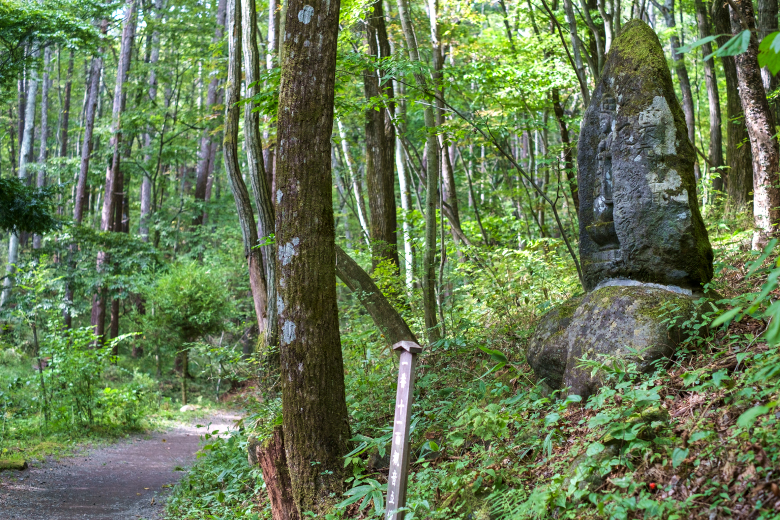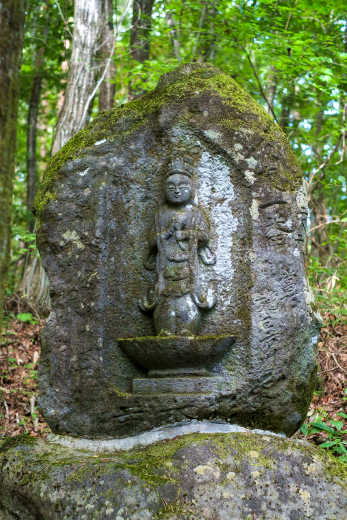The Stone Buddhist Images of Bomichi Road were ensconced along the road in the late Edo Period (1603–1868) as milestones for travelers and merchants. They were created in the images of the Kannon statues of Saigoku Sanjusankasho (Thirty-three Pilgrimage Temples in Saigoku) and Bando Sanjusankasho (Thirty-three Pilgrimage Temples in Bando). Thirty-nine of them remain today.
The pilgrimage route they comprise was modeled after sacred places of Kannon worship that became popular throughout the country during the Edo Period. It was believed that making a pilgrimage of the Stone Buddhist Images along Bomichi Road had the same merit as making a pilgrimage of the temples.
Each of the Stone Buddhist Images is inscribed with a temple number, accompanied in some by a pilgrim’s hymn (Japanese poem that brings merit when recited at a temple during a pilgrimage), donor of the image, and the date the image was erected. Initially, a hundred images were planned to be created combined with the images of Chichibu Sanjuyonkasho (Thirty-four Pilgrimage Temples in Chichibu), but the sequence seems to have ended with the sixteenth temple of Bando near the border between former Kobuchisawa-mura and former Koarama-mura Villages. There are six types of images, including images of Sho Kannon, Eleven-faced Kannon, Senju Kannon, Nyoi Rinkannon, Bato Kannon, and Fukukensaku Kannon, closely corresponding to the different types of deities enshrined in the temples of Saigoku and Bando.
Many of the images commonly display a rather large face, perhaps to emphasize their facial expression, and an attire with an upturned hem. They are made of igneous rocks from Mount Yatsugatake, such as andesite and basalt, but display various conditions. Some are green on the surface due to the copper component seeping out from the rock, and some are white due to the adhesion of lichen (type of algae). The shapes of the aureola (decorative rays of light that surround a Buddhist image or appear to emanate from an incarnation) also differ from image to image. In some, the natural shape of the rock is used to express the aureola, and in others, the aureola is carved into the rock. An enriching experience can be gained by walking the pilgrimage route while comparing the details of the images, such as their expression, shape, appearance of the stone material, and chisel marks.
Flowers and foods are sometimes offered to the Stone Buddhist Images. Precisely because they are well taken care of in this way by the local community, as many as thirty-nine images have survived over the years from the late-Edo Period to today.
The pilgrimage route they comprise was modeled after sacred places of Kannon worship that became popular throughout the country during the Edo Period. It was believed that making a pilgrimage of the Stone Buddhist Images along Bomichi Road had the same merit as making a pilgrimage of the temples.
Each of the Stone Buddhist Images is inscribed with a temple number, accompanied in some by a pilgrim’s hymn (Japanese poem that brings merit when recited at a temple during a pilgrimage), donor of the image, and the date the image was erected. Initially, a hundred images were planned to be created combined with the images of Chichibu Sanjuyonkasho (Thirty-four Pilgrimage Temples in Chichibu), but the sequence seems to have ended with the sixteenth temple of Bando near the border between former Kobuchisawa-mura and former Koarama-mura Villages. There are six types of images, including images of Sho Kannon, Eleven-faced Kannon, Senju Kannon, Nyoi Rinkannon, Bato Kannon, and Fukukensaku Kannon, closely corresponding to the different types of deities enshrined in the temples of Saigoku and Bando.
Many of the images commonly display a rather large face, perhaps to emphasize their facial expression, and an attire with an upturned hem. They are made of igneous rocks from Mount Yatsugatake, such as andesite and basalt, but display various conditions. Some are green on the surface due to the copper component seeping out from the rock, and some are white due to the adhesion of lichen (type of algae). The shapes of the aureola (decorative rays of light that surround a Buddhist image or appear to emanate from an incarnation) also differ from image to image. In some, the natural shape of the rock is used to express the aureola, and in others, the aureola is carved into the rock. An enriching experience can be gained by walking the pilgrimage route while comparing the details of the images, such as their expression, shape, appearance of the stone material, and chisel marks.
Flowers and foods are sometimes offered to the Stone Buddhist Images. Precisely because they are well taken care of in this way by the local community, as many as thirty-nine images have survived over the years from the late-Edo Period to today.
COURSE MAP
Let's go to the next spot!
- 100m / 3 on foot Minutes
- 14Saigoku number 33 Eleven-faced Kannon

